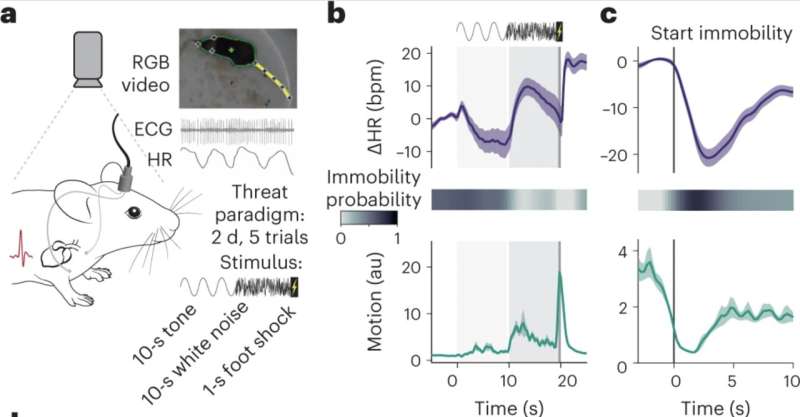February 24, 2023 feature
This article has been reviewed according to Science X's editorial process and policies. Editors have highlighted the following attributes while ensuring the content's credibility:
fact-checked
peer-reviewed publication
trusted source
proofread
A framework characterizing the cardio-behavioral responses associated with fear and anxiety

Anxiety disorders are becoming increasingly common, with estimates suggesting that almost one in three people in the U.S. will experience high levels of anxiety at some point in their life. Anxiety is essentially a feeling of unease, worry or psychological discomfort, typically associated with catastrophic thoughts about a real or imagined future life event.
When they are anxious, humans experience the same sensations and physiological responses they would feel when they are afraid of a real and immediate threat, such as a lion chasing them, an ongoing natural disaster, and so on. To better support patients with anxiety disorders, neuroscientists and psychology researchers have been trying to understand the neural underpinnings of fear and anxiety for many years.
Ultimately, both fear and anxiety tend to promote defensive behaviors in response to real or imaginary threats, respectively. The most widely documented among these are the so-called freeze (i.e., staying still), flight (i.e., avoiding a feared situation or escaping), fight (i.e., arguing or becoming aggressive) and fawn (i.e., overpleasing or submitting to another human to avoid the escalation of conflict).
A team of researchers at University Hospital Wuerzburg in Germany, recently carried out a study concurrently investigating both cardiac and behavioral responses associated with anxiety and fear-based defensive states in mice. Their paper, published in Nature Neuroscience, introduces a new framework that could be used to characterize the complex cardio-behavioral defensive states experienced by animals and humans when they are feeling fearful or anxious.
"The defense reaction includes multiple interacting behavioral, autonomic and endocrine adjustments, but their integrative nature is poorly understood," Jérémy Signoret-Genest, Nina Schukraft and their colleagues wrote in their paper. "In particular, although threat has been associated with various cardiac changes, there is no clear consensus regarding the relevance of these changes for the integrated defense reaction."
The key objective of the recent work by Signoret-Genest, Schkraft and their colleagues was to gain a better understanding of anxiety and fear from a cardiac, physiological and behavioral standpoint. To do this, they analyzed a large dataset collected during experiments with mice, which included behavioral, heart-rate and thermal measurements.
During the experiments in which this data was collected, freely moving mice were implanted with electrocardiogram (ECG) electrodes and then exposed to a particular pattern of stimuli, namely a sound (i.e., a pure tone) and a mild electrical shock applied to their feet. The mice soon learned to associate the sound with the following painful stimulus, thus they exhibited anxious behaviors when they heard it.
Throughout this experiment, the mice's cardiac and physiological responses were recorded, to better understand its relation to the defensive behaviors they were performing. By analyzing collected measurements, the researchers were able to identify a cardio-behavioral microstate that occurred after the mice heard the sound, which was characterized by a lack of body movements (i.e., freezing or immobility) a decrease in heart rate, also known as bradycardia.
Interestingly, as the mice became more and more conditioned to fear the sound, or in other words the more times they had experienced the electrical shock following the sound, this cardio-behavioral state progressively increased. They then also identified other microstates in which the mice's behavior was consistently associated with a faster heart rate (i.e., tachycardia).
"We identify rapid microstates that are associated with specific behaviors and heart rate dynamics, which are affected by long-lasting macrostates and reflect context-dependent threat levels," Signoret-Genest and Schukraft explained in their paper. "In addition, we demonstrate that one of the most commonly used defensive behavioral responses—freezing as measured by immobility—is part of an integrated cardio-behavioral microstate mediated by Chx10+ neurons in the periaqueductal gray."
The recent study by this team of researchers offers new interesting insight about the cardiac, physiological and behavioral underpinnings of defensive states. Overall, it confirms previous hypothesis and observations suggesting that defensive states are marked by a series of concurrent and interdependent processes.
In the future, the framework they developed and the cardio-behavioral microstates they identified could be explored further, potentially paving the way towards an improved understanding of anxiety disorders and the body processes that characterize them. This could in turn inform clinical practices, for instance helping psychotherapists to better guide their patients in becoming aware of cardiac and physiological responses that occur when they are experiencing anxiety.
"Our framework for systematic integration of cardiac and behavioral readouts presents the basis for a better understanding of complex neural defensive states and their associated systemic functions," the researchers wrote in their paper.
More information: Jérémy Signoret-Genest et al, Integrated cardio-behavioral responses to threat define defensive states, Nature Neuroscience (2023). DOI: 10.1038/s41593-022-01252-w
© 2023 Science X Network


















